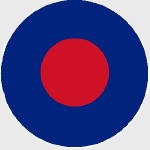Corgi AA28903 RAF Bristol Beaufort Mk.1a Bomber - EK979, Middle East Check and Conversion Unit, Egypt, 1944 (1:72 Scale)
"Woe to the unwary"
- Motto of No.217 Squadron
 The Bristol Beaufort (manufacturer designation Type 152) is a British twin-engined torpedo bomber designed by the Bristol Aeroplane Company, and developed from experience gained designing and building the earlier Blenheim light bomber. At least 1,180 Beauforts were built by Bristol and other British manufacturers.
The Bristol Beaufort (manufacturer designation Type 152) is a British twin-engined torpedo bomber designed by the Bristol Aeroplane Company, and developed from experience gained designing and building the earlier Blenheim light bomber. At least 1,180 Beauforts were built by Bristol and other British manufacturers.
The Australian government's Department of Aircraft Production (DAP) also manufactured variants of the Beaufort. These are often known collectively as the DAP Beaufort. More than 700 Australian-built Beauforts saw service with the Royal Australian Air Force in the South West Pacific theatre, where they were used until the end of the war.
Beauforts first saw service with Royal Air Force Coastal Command and then the Royal Navy Fleet Air Arm from 1940. They were used as torpedo bombers, conventional bombers and mine-layers until 1942, when they were removed from active service and were then used as trainer aircraft until being declared obsolete in 1945. Beauforts also saw considerable action in the Mediterranean; Beaufort squadrons based in Egypt and on Malta helped interdict Axis shipping supplying Rommel's Deutsches Afrikakorps in North Africa.
Although it was designed as a torpedo-bomber, the Beaufort was more often used as a medium day bomber. The Beaufort also flew more hours in training than on operational missions and more were lost through accidents and mechanical failures than were lost to enemy fire. The Beaufort was adapted as a long-range heavy fighter variant called the Beaufighter, which proved to be very successful and many Beaufort units eventually converted to the Beaufighter.
Pictured here is a 1:72 scale RAF Bristol Beaufort Mk.1a bomber that was attached to the Middle East Check and Conversion Unit, located in Egypt during 1944.
Pre-order! Ship Date: March 2025.
Dimensions:
Wingspan: 9-3/4-inches
Length: 7-inches
Release Date: February 2025
Historical Account: "Re-Training" - Following the introduction of the Bristol Beaufighter in a maritime strike role, many Beaufort squadrons were subsequently sent to operate from bases in the Mediterranean and Middle East and after a significant re-organization in theatre during late 1941 and early 1942, would once again find themselves taking a heavy toll of Axis shipping. Beauforts arrived in Egypt from around August 1941, where they would replace Blenheims and Martin Marylands, which had previously been holding the line, with all aircraft in this region looking very different to those operating from Britain, by virtue of their attractive desert camouflage scheme they wore.
It has been reported that as Axis shipping virtually stopped operating by day, the Mediterranean Beauforts spent more time engaged in training sorties than they did flying offensive strikes and as a consequence, more aircraft would be lost in accidents and to mechanical failures, than as a result of enemy action. Nevertheless, Beauforts did prove ruthlessly effective in mauling Axis shipping in the Mediterranean, preventing the resupply of the Afrika Korps by sea, enabling ground forces to continually have the Germans on the retreat, eventually bringing about the surrender of the Afrika Korps.
Later in the war, Mediterranean Beauforts were equipped with ASV radar equipment, in an attempt to assist crews in locating the ever more elusive Axis shipping by day and by night, with the war taking a significant turn in favor of the Allies.






